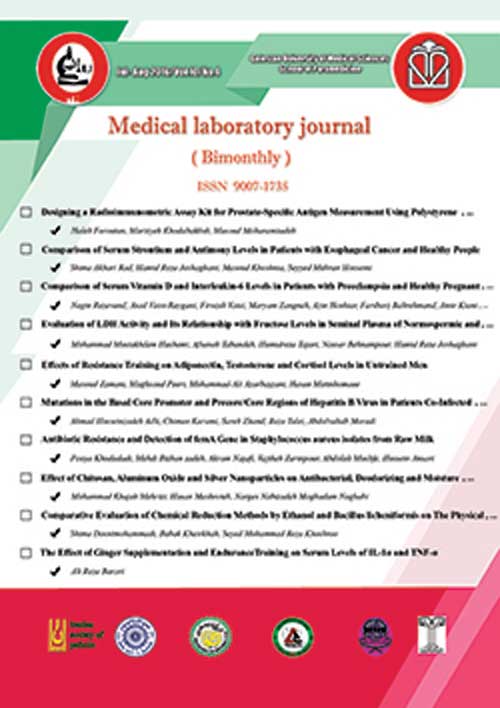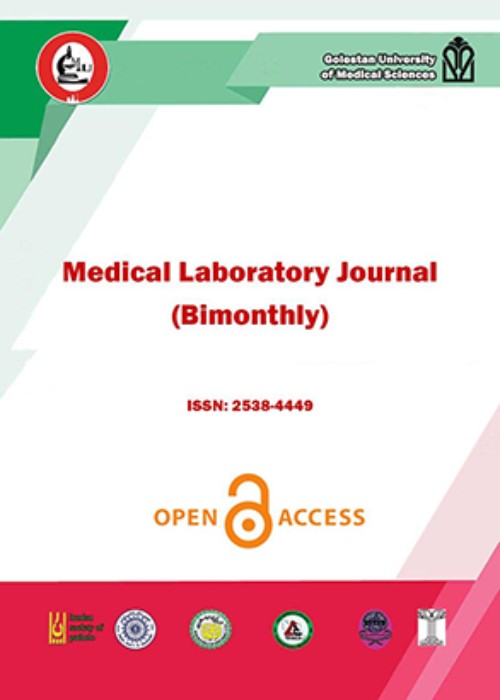فهرست مطالب

Medical Laboratory Journal
Volume:11 Issue: 2, Mar-Apr 2017
- تاریخ انتشار: 1396/02/10
- تعداد عناوین: 8
-
-
Pages 1-4Background And ObjectivesThe incidence rate of esophageal cancer (EC) is high in north and northeast of Iran. Taurine is a sulfur-containing amino acid with a wide range of vital biological functions. The aim of this study was to compare plasma levels of taurine between patients with EC and healthy controls.
MethodsPlasma samples from 36 recently diagnosed cases of EC and 36 healthy adults were analyzed by high-pressure liquid chromatography. Data analysis was done using SPSS (version 16). The t-test was used to evaluate significant differences in the level of taurine between the two groups. P-values less than 0.05 were considered statistically significant.
ResultsPatients with EC had significantly higher levels of plasma taurine compared with the controls (PConclusionPatients with EC have significantly higher levels of plasma taurine compared with healthy individuals. This finding suggests that the measurement of plasma taurine in patients with EC could be useful for the early diagnosis of the disease.Keywords: Esophageal Cancer, Taurine, HPLC -
Pages 5-10Background And ObjectivesSynthesis and characterization of several metal complexes (metal ions: Co2, Ti4 and Ce3) of macroacyclic Schiff base ligand have been reported. The Schiff base ligand is prepared from the condensation reaction of 1, 4-di-(4-fluoro-2-aminophenoxy) butane with salicylaldehyde in ethanol. In addition, antibacterial activity of metal ions, Schiff base ligand and their complexes have been investigated. Recent studies show that many Schiff base complexes have antibacterial activity against Gram-positive and Gram-negative bacteria. Therefore, we aimed to synthesize new Schiff base complexes and evaluate their antibacterial activity against a number of Gram-positive and Gram-negative bacteria.
MethodsSchiff base ligand and their complexes were characterized by mass spectrometry and IR, H-NMR and C-NMR spectroscopy. The in vitro antibacterial activity of the Schiff base ligand, metal ions and their complexes were evaluated against some Gram-positive and Gram-negative bacteria by disk diffusion method and determining minimum inhibitory concentration.
ResultsIn this study, the Schiff base complexes had good antibacterial activity, but the Schiff base ligand and metal ions did not show any antibacterial effect. In some cases, the antibacterial effect of the complexes was higher than that of the standard antibiotics tetracycline and gentamycin. The titanium complex showed the highest antibacterial activity in both methods. This complex created the largest growth inhibition zone (diameter: 100mm) against Staphylococcus aureus, and had the lowest minimum inhibitory concentration against Bacillus subtilis (6.75 mg/ml).
ConclusionThe compounds synthesized in our study have strong antibacterial activity.Keywords: Schiff base complex, Schiff base ligand, antibacterial activity, Staphylococcus aureus, Bacillus subtilis -
Pages 11-15Background And ObjectivesExposure to ionizing radiation in modern societies is inevitable and can cause a variety of adverse health effects such as cancer and birth defects. Therefore, a reliable, repeatable and sensitive method is required for evaluation of radiation exposure. The aim of this study was to determine the amount of histone H2AX phosphorylation as an indicator of radiation exposure to evaluate the rate of double-strand DNA breakage in irradiated mice.
MethodsIn this study, 15 mice were exposed to different doses of ionizing radiation. After extraction of total protein from bone marrow cells, γH2AX protein was measured by western blotting. Data analysis was performed using ANOVA, Tukey's post hoc test, and the Pearson's correlation test.
ResultsThe amount of γH2AX protein in the exposed groups increased significantly compared to the control group (PConclusionThe results of this study indicate that exposure to ionizing radiation increases the amount of γH2AX protein in bone marrow cells during the early hours. The protein can be used as a biomarker for monitoring of acute radiation or suspected local radiation exposure.Keywords: ?H2AX Protein, Ionizing Radiation, Mouse -
Pages 16-20Background And ObjectivesIvermectin is an anti-parasitic medication frequently used in many food-producing animals. This study aimed to investigate the level of ivermectin residue in liver samples collected from slaughterhouses in Qazvin Province, Iran.MethodsOverall, 88 bovine liver samples were randomly collected and analyzed for detection of ivermectin residues. The samples were analyzed for ivermectin contamination by enzyme-linked immunosorbent assay (ELISA) and high-performance liquid chromatography (HPLC). The samples were extracted using liquid-liquid extraction procedure for the ELISA. Solid phase extraction using a C18 column followed by fluorescence-derivatized with 1-methylimidazole and trifluoroacetic anhydride in acetonitrile were used for the HPLC assay. Recovery values obtained from the HPLC method ranged from 81.3 to 92.5%, with a relative standard deviation of 6.7-12.2%.ResultsFirst, all samples were screened by the ELISA method. Based on the results, 16 samples (18.2%) contained no detectable levels of Ivermectin residue, while Ivermectin was found in 72 samples (81.8%). In addition, 22 of the positive samples (30.55%) contained high Ivermectin level (>50 ppb). Analysis of the samples by the HPLC method showed that eight samples (9.09%) contained ivermectin levels above the maximum residue limit.ConclusionThis study demonstrates the presence of different levels of Ivermectin residue in bovine liver samples collected from the Qazvin Province in Iran. Therefore, regulatory authorities should ensure proper withdrawal period before slaughter of the animals.Keywords: Ivermectin, Cattle, Liver, ELISA, HPLC
-
Pages 21-25Background And ObjectiveMycotoxins are a group of relatively resistant toxic metabolites. The most important mycotoxins are aflatoxins (B1 and B2, G1 and G2), which originate from contaminated animal feed. Dairy cattle transmit aflatoxins B1 and B2 through milk in form of aflatoxins M1 and M2, and endanger the human health. Traditional buffalo farms play an important role in the supply of dairy products in Khuzestan Province. In addition, the province has suitable conditions for the growth of various types of fungi. Therefore, this study aimed to determine the amount of aflatoxins in buffalo feed samples collected from two main suppliers of milk in the province (Ahvaz and Karun).
MethodsOverall, 60 samples were collected during the 3 months of autumn 2014. Samples were analyzed by the sensitive and fast method of competitive enzyme-linked immunosorbent assay.
ResultsThe concentration of aflatoxin ranged from 0.77 to 64.85 μg/Kg. In addition, the concentration of aflatoxin in 21 samples was higher than the permitted limit (25 μg/Kg).
ConclusionThe mean concentration of aflatoxin in the samples increases with the decrease in temperature and humidity. This increase is observed in Ahvaz at a higher rate, which could be due to inappropriate storage and use of rice bran in their feed.Keywords: Aflatoxins, Ahvaz, Animal Feed -
Pages 26-29Background And ObjectiveThis descriptive study aimed to evaluate the presence and frequency distribution of mosquito species in the city of Port Sudan, Sudan.
MethodsAfter collection of 500 adult mosquitoes from different sectors of the city Port Sudan, they were classified using the morphological keys for identification of mosquitoes.
ResultsOverall, 230 Culex quinquefasciatus (46%) were detected in the eastern, central and southern sectors of the city. Culex sitiens (14.2%) were detected only in the central sector. Aedes aegypti (32.2%) were detected in all three sectors. Anopheles funestus (6.6%) were detected in the central and southern sectors.
ConclusionCx. quinquefasciatus and Ae. aegypi are prevalent in all sectors of the city, while Cx. sitiens is prevalent only in the central sector. An. funestus is abundant in the central and southern sectors.Keywords: Culicidae, Morphological, Microscopic Findings, Eastern Sudan -
Pages 30-35Background And ObjectiveEscherichia coli is one of the most common causes of hospital-acquired infections. Extended-spectrum β-lactamase (ESBL)-producing E. coli strains are resistant to third-generation cephalosporins. The three main genes involved in ESBL production are TEM, SHV and CTX-M. Detection of ESBL-producing E. coli is of importance for infection control, reduction of excessive antibiotic use and epidemiological surveillance. This study aimed to detect ESBL-producing E. coli strains isolated from wound infections using phenotypic and molecular methods.
MethodsDuring 2013- early 2015, 86 strains were collected from three hospitals in Isfahan, Iran. Antibiotic susceptibility testing was done using ceftazidime and ceftazidime clavulanic acid discs. Polymerase chain reaction was used for the detection of the three resistance genes.
ResultsThe resistance genes SHV, CTX-M and TEM were detected in 49 isolates (56.9%). In addition, 39 isolates (45%) were ESBL-producing strains. According to the results, 5 (5.8%), 14 (16.2%), 19 (22%) and 11 (12.7%) isolates contained the SHV, CTX-M, TEM and CTX-M TEM genes, respectively. The frequency of CTX and TEM were significantly higher than that of SHV gene (PConclusionsThere is a difference between the frequency of ESBL-positive isolates reported in the phenotypic and genotypic methods, which could be due to the lower sensitivity of the phenotypic method and impact of environmental factors on the emergence of antibiotic resistance.Keywords: Antibiotic resistance genes, ESBL, TEM, SHV, CTX-M, Escherichia coli -
Pages 36-40Background And ObjectiveCampylobacters are infectious zoonotic agents, and among the main bacterial causes of gastroenteritis in humans. Studies have shown that Campylobacter jejuni is of the main causes of infection among humans. Detection of these infectious agents in water resources is of great importance for maintaining the health of humans. Therefore, the aim of this study was molecular detection of C. jejuni strains in surface water samples collected from Rasht, Iran.
MethodsThis cross-sectional descriptive study was performed on 45 surface water samples collected from the city of Rasht. After culture and isolation of bacteria, the molecular detection of C. jejuni was carried out using hipO-specific primers. Presence of cytolethal distending toxin (cdt) gene in positive samples was evaluated by polymerase chain reaction using cdtC-specific primers.
ResultsOf 45 samples, seven (15.5%) were positive for C. jejuni contamination, five of which (71.4%) had the cdtC gene.ConclusionThe prevalence of toxin-producing C. jejuni in surface waters of Rasht is notable. Therefore, it is recommended to take necessary measures for controlling the spread of this microorganism.Keywords: Campylobacter jejuni, Surface water, cdt gene, PCR


